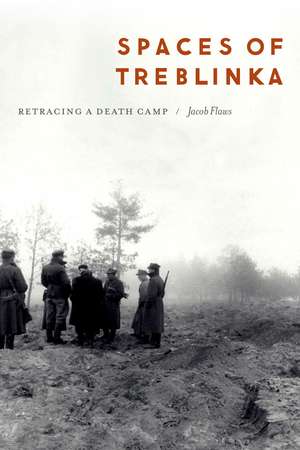Spaces of Treblinka: Retracing a Death Camp
Autor Jacob Flawsen Limba Engleză Hardback – noi 2024
Through spatial reality, Flaws portrays the conceptions, fantasies, ideological assumptions, and memories of Treblinka from witnesses in the camp and surrounding towns. To do so he identifies six key spaces that once composed the historical site of Treblinka: the ideological space, the behavioral space, the space of life and death, the interactional space, the sensory space, and the extended space. By examining these spaces Flaws reveals that there were more witnesses to Treblinka than previously realized, as the transnational groups near and within the camp overlapped and interacted. Spaces of Treblinka provides a staggering and profound reassessment of the relationship between knowing and not knowing and asks us to confront the timely warning that we, in our modern, interconnected world, can all become witnesses.
Preț: 430.44 lei
Nou
Puncte Express: 646
Preț estimativ în valută:
82.37€ • 85.51$ • 68.69£
82.37€ • 85.51$ • 68.69£
Carte tipărită la comandă
Livrare economică 22 martie-05 aprilie
Preluare comenzi: 021 569.72.76
Specificații
ISBN-13: 9781496239730
ISBN-10: 1496239733
Pagini: 314
Ilustrații: 21 photographs, 1 illustration, 2 maps, index
Dimensiuni: 152 x 229 mm
Greutate: 0.63 kg
Editura: Nebraska
Colecția University of Nebraska Press
Locul publicării:United States
ISBN-10: 1496239733
Pagini: 314
Ilustrații: 21 photographs, 1 illustration, 2 maps, index
Dimensiuni: 152 x 229 mm
Greutate: 0.63 kg
Editura: Nebraska
Colecția University of Nebraska Press
Locul publicării:United States
Notă biografică
Jacob Flaws is an assistant professor of history at Kean University.
Cuprins
Introduction
1. An Ideological Space
2. A Behavioral Space
3. A Space of Life and Death
4. An Interactional Space
5. A Sensory Space
6. An Extended Space
Conclusion
Bibliography
Index
1. An Ideological Space
2. A Behavioral Space
3. A Space of Life and Death
4. An Interactional Space
5. A Sensory Space
6. An Extended Space
Conclusion
Bibliography
Index
Recenzii
“Jacob Flaws’s spatial history of Treblinka invites us to consider the camp not only as a fenced-off site, but one connected to the world outside through flows of transports, sounds and smells, escaped prisoners, and information. He offers a dynamic spatial history of the Holocaust through analysis of one of its most important places. It is suggestive of the importance of thinking not only about the interactions of multiple groups and individuals but also about the overlapping of multiple scales.”—Tim Cole, author of Holocaust Landscapes
“Jacob Flaws’s sophisticated and expert analysis of Treblinka offers a major and fundamental contribution to the field of Holocaust studies based on the strength of the argument and the wealth of primary and secondary sources. . . . This is a cutting-edge approach within current Holocaust studies. . . . The account does not sacrifice the importance of individual human experience in favor of theory but rather does an excellent job of marrying the two together.”—Edward Westermann, author of Drunk on Genocide: Alcohol and Mass Murder in Nazi Germany
“With his remarkable range of sources and careful attention to time, place, and emotion, Jacob Flaws allows us to understand Treblinka in a way that few previous historians have. Spaces of Treblinka reveals a site by no means hidden away but smelled, heard, seen, and interacted with for miles around.”—Dan Stone, author of The Holocaust: An Unfinished History
“I have rarely read such a well-written, powerful, important work. . . . The balance between victims, perpetrators, and what scholars used to call bystanders is exceptionally good. . . . The quality of the writing is matched by the clarity of Flaws’s vision for the book and a number of novel concepts that frame his analysis. ‘Zones of witnessing’ is particularly apt and will be picked up by many readers interested in the ongoing spatial turn in Holocaust studies.”—Anne Kelly Knowles, coeditor of Geographies of the Holocaust
Descriere
Using an innovative approach that puts Jewish, German, and Polish voices together to map the impacts of the Treblinka death camp near and far, Spaces of Treblinka reconceptualizes the relationship between sites of mass atrocity and the spaces surrounding them.
